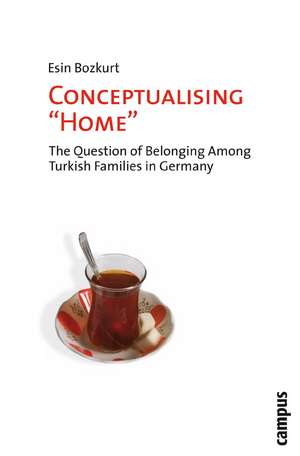Conceptualising "Home": The Question of Belonging among Turkish Families in Germany
Autor Esin Bozkurten Limba Engleză Paperback – 17 sep 2009
An extraordinarily rich account of the lives of Turkish men and women living in contemporary Germany, Conceptualising 'Home' offers striking insights into how members of a marginalized immigrant community make room for themselves and reconstruct homes away from home. Based on in-depth interviews, the volume places the life experiences of Turkish people into a broader theoretical perspective, while Esin Bozkurt's careful attention to gender and generational differences ensures an accurate, balanced representation. The result is a surprisingly useful understanding of the very idea of "home."
Preț: 313.77 lei
Preț vechi: 400.59 lei
-22% Nou
Puncte Express: 471
Preț estimativ în valută:
60.07€ • 62.44$ • 49.80£
60.07€ • 62.44$ • 49.80£
Carte indisponibilă temporar
Doresc să fiu notificat când acest titlu va fi disponibil:
Se trimite...
Preluare comenzi: 021 569.72.76
Specificații
ISBN-13: 9783593387918
ISBN-10: 3593387913
Pagini: 245
Dimensiuni: 140 x 213 x 18 mm
Greutate: 0.33 kg
Editura: CAMPUS VERLAG
Colecția Campus Verlag
ISBN-10: 3593387913
Pagini: 245
Dimensiuni: 140 x 213 x 18 mm
Greutate: 0.33 kg
Editura: CAMPUS VERLAG
Colecția Campus Verlag
Notă biografică
Esin Bozkurt studied issues of culture, identity, belonging, migration, and gender at Istanbul Bilgi University, Turkey.
Cuprins
Introduction
The scope of the study
The question of ‘home’ in the context of the study
Research approach
The organization of dissertation
PART 1: HOME, HEIMAT, ‘VATAN’ AND BELONGING
1. Conceptualising home
1.1. Introduction
1.2. Defining home across three socio-linguistic contexts
1.3. Conceptualising home
1.4. Re-conceptualising home/s after migration
PART 2: TURKISH MIGRATION TO GERMANY: GENDER AND GENERATIONAL DIFFERENCES IN BELONGING
2. Turkish immigrants in Germany: Generations, experiences, belongings
2.1. Introduction
2.2. The First Generation
2.3. The second generation
2.4. The third generation
3. Gender in the experience of migration and home-making
3.1. Introduction
3.2. Gender and migration research
3.3. Gendered aspects of Turkish migration to Germany and the post-migration employment of Turkish women
3.4. Women and home/s: Travelling men and home-making women
3.5. Conclusions and outlook
PART 3: EMPIRICAL RESEARCH4. Empirical Research
4.1. Recapitulation of research objectives
4.2. Research Questions
4.3. Research Methods
4.3.1. Qualitative Research: Problem-Centred Interviews
4.3.2. Breaking into the field: ‘Heard about the one from Turkey?’
4.3.3. Data Analysis
PART 4: RESULTS: HOMES ACROSS GENERATIONS AND GENDER
5. Homes across three generations
5.1. Introduction
5.2. From guests to commuters: The first generation
5.3. Claiming home: The second generation
5.4. Fighting for belonging: The third generation
6. Gender differences in the experience of migration and conceptualisation of home among Turkish immigrants
6.1. The profile of male and female participants
6.2. Gender in the process of migration
6.3. Gendered ‘home/s’
6.4. Return orientations
6.5. Conclusions
7. Home/s at the crossroads of gender and generations in and across families
7.1. Introduction
7.2. Common themes and shared patterns of communication across families and generations
ng=EN-GB style="mso-ansi-language: EN-GB"7.3. Differences across families: Changing emphases on culture, nation and religion
7.4. Gendered communication of belonging across generations
7.4.1. Women and communication
7.4.2. Men and communication
7.5. Conclusions
8. Conclusions
8.1. Recollecting fragments, reconsidering belongings
The first generation: From breezy homes to heavy lives
The second generation: Leaving and arriving. A matter of breathing
The third generation: Incomplete lives, substitute homes
Generational differences in and across familial contexts
8.2. Implications of the study
References
Appendix 1
Appendix 2
Appendix 3
The scope of the study
The question of ‘home’ in the context of the study
Research approach
The organization of dissertation
PART 1: HOME, HEIMAT, ‘VATAN’ AND BELONGING
1. Conceptualising home
1.1. Introduction
1.2. Defining home across three socio-linguistic contexts
1.3. Conceptualising home
1.4. Re-conceptualising home/s after migration
PART 2: TURKISH MIGRATION TO GERMANY: GENDER AND GENERATIONAL DIFFERENCES IN BELONGING
2. Turkish immigrants in Germany: Generations, experiences, belongings
2.1. Introduction
2.2. The First Generation
2.3. The second generation
2.4. The third generation
3. Gender in the experience of migration and home-making
3.1. Introduction
3.2. Gender and migration research
3.3. Gendered aspects of Turkish migration to Germany and the post-migration employment of Turkish women
3.4. Women and home/s: Travelling men and home-making women
3.5. Conclusions and outlook
PART 3: EMPIRICAL RESEARCH4. Empirical Research
4.1. Recapitulation of research objectives
4.2. Research Questions
4.3. Research Methods
4.3.1. Qualitative Research: Problem-Centred Interviews
4.3.2. Breaking into the field: ‘Heard about the one from Turkey?’
4.3.3. Data Analysis
PART 4: RESULTS: HOMES ACROSS GENERATIONS AND GENDER
5. Homes across three generations
5.1. Introduction
5.2. From guests to commuters: The first generation
5.3. Claiming home: The second generation
5.4. Fighting for belonging: The third generation
6. Gender differences in the experience of migration and conceptualisation of home among Turkish immigrants
6.1. The profile of male and female participants
6.2. Gender in the process of migration
6.3. Gendered ‘home/s’
6.4. Return orientations
6.5. Conclusions
7. Home/s at the crossroads of gender and generations in and across families
7.1. Introduction
7.2. Common themes and shared patterns of communication across families and generations
ng=EN-GB style="mso-ansi-language: EN-GB"7.3. Differences across families: Changing emphases on culture, nation and religion
7.4. Gendered communication of belonging across generations
7.4.1. Women and communication
7.4.2. Men and communication
7.5. Conclusions
8. Conclusions
8.1. Recollecting fragments, reconsidering belongings
The first generation: From breezy homes to heavy lives
The second generation: Leaving and arriving. A matter of breathing
The third generation: Incomplete lives, substitute homes
Generational differences in and across familial contexts
8.2. Implications of the study
References
Appendix 1
Appendix 2
Appendix 3
